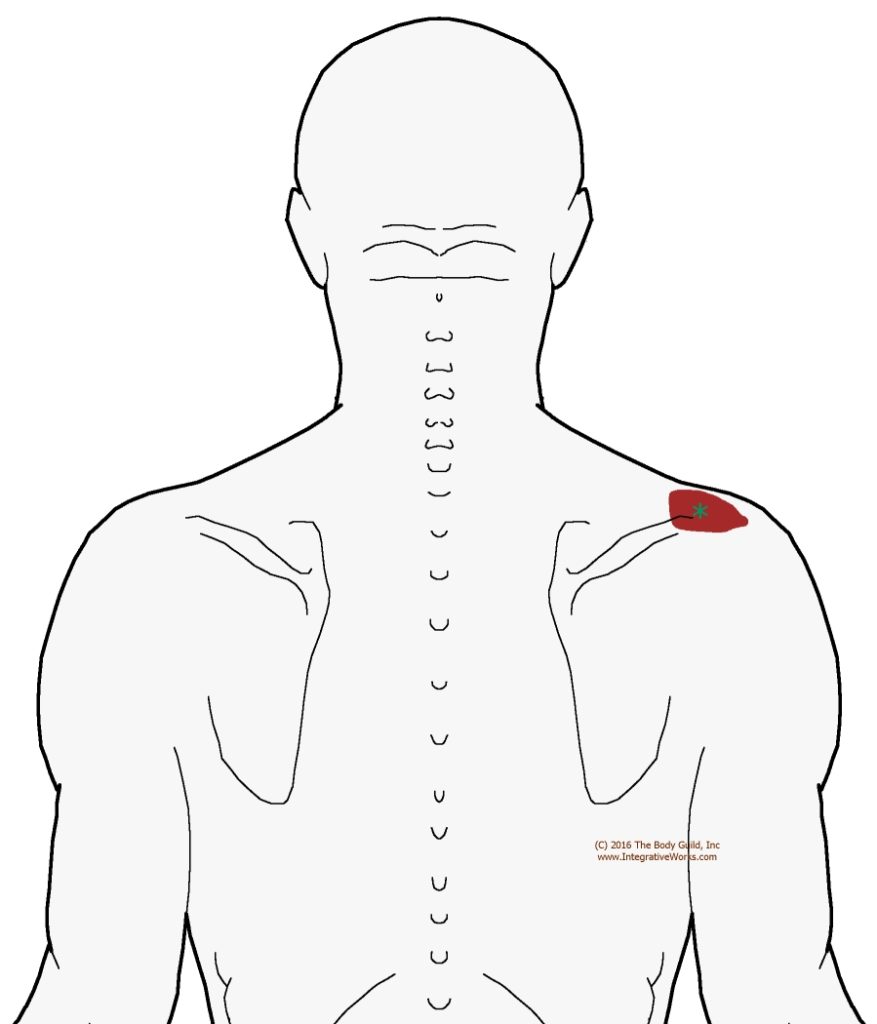Sore Shoulder from Strap or Lifting Overhead
Table of Contents
- How People Describe This Pain Pattern
- How You Activate and Intensify This Pain Pattern
- Self-Care – Getting Relief on Your Own
- Musculoskeletal Anatomy Behind Your Pain
- Therapy Notes for Massage and Bodywork
How People Describe This Pain Pattern


Active people complain of pain on the top of their shoulder when lifting their arm. When I ask them to lift their arm, it doesn’t really hurt until their elbow gets level with their shoulder and the tip of the shoulder begins to rotate upward.
This is the motion that strongly engages the middle trapezius. Sometimes they will produce the pain by wiggling around their shoulder until they lift it up and back. They also complain of pain during exercises that lift their arm above their head, which also rotates the scapula upward.
How You Activate and Intensify This Pain Pattern
People who carry something with a strap over the shoulder have tenderness on that spot where the bag presses into the shoulder. They will shift their purse, baby bag, travel bag, or yoga bag to the other shoulder and smile as they tell me that the bag is probably causing the problem. This combination doubly aggravates this spot as it presses into the trigger point while the trapezius is rotating the shoulder up to keep the bag in place. People with a backpack may carry it by the strap or just put it on the other shoulder.
People may also complain of a heavy coat that rides their sore shoulder, leaving them irritated. Children with sensory processing disorders may complain that they “just don’t like” their coat or backpack.
A few different motions aggravate this.
- First, lifting the shoulder toward the ear. It usually happens because people lift their elbow above the shoulder. This extended side pose is a good example of that movement. It lifts the elbow above the head while opening the chest by retracting the scapula.
- Second, people have something that presses into the top of the shoulder. Backpack. Shoulder bag. Squat bar. Kid on your shoulders. The pressure into the muscle activates the trigger point as it lengthens.
- Third, and less common, people raise their shoulders to type, eat, work on their laptops, etc. This is less likely to aggravate this muscle as it often acts as an assistant in this motion. But it happens. Sometimes.
The Musculoskeletal Anatomy Behind Your Pain
Musculoskeletal Anatomy
This post on anatomy contains standard information about the origin, insertion, function, and innervation of muscles. Additionally, it includes information on functional considerations and anomalies.
Find Related Posts
Anatomy posts have a grid of all related posts. This includes posts on pain patterns, self-care, therapy notes, NMT protocols, cranial techniques, and cases.
Getting Relief on Your Own
Clinically Proven
Self-Care Strategies
Self-Care Posts have common sections to make them easy to follow and understand:
- Activities to Avoid or Change
- Strategies for Quick Relief
- Stretches and Exercise for Longer-Lasting Relief
- Yoga Corner
Therapy Notes for Massage and Bodywork
Better Bodywork
Through Shared Expertise
This post has techniques, tips, treatment routines, and anatomy illustrations to improve the bodyworker’s approach.
Support Integrative Works to
stay independent
and produce great content.
You can subscribe to our community on Patreon. You will get links to free content and access to exclusive content not seen on this site. In addition, we will be posting anatomy illustrations, treatment notes, and sections from our manuals not found on this site. Thank you so much for being so supportive.
Cranio Cradle Cup
This mug has classic, colorful illustrations of the craniosacral system and vault hold #3. It makes a great gift and conversation piece.
Tony Preston has a practice in Atlanta, Georgia, where he sees clients. He has written materials and instructed classes since the mid-90s. This includes anatomy, trigger points, cranial, and neuromuscular.
Question? Comment? Typo?
integrativeworks@gmail.com
Follow us on Instagram
*This site is undergoing significant changes. We are reformatting and expanding the posts to make them easier to read. The result will also be more accessible and include more patterns with better self-care. Meanwhile, there may be formatting, content presentation, and readability inconsistencies. Until we get older posts updated, please excuse our mess.